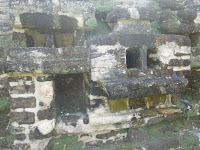 My travel in Belize has taken me 53 miles north of Belize
City, to the town of Orange Walk. Orange
Walk Town has a population in the vicinity of 13,400. The people are a mix of Mestizo, Kriol,
Mennonite, Chinese, Taiwanese, Indian and people from other Central American
countries.
My travel in Belize has taken me 53 miles north of Belize
City, to the town of Orange Walk. Orange
Walk Town has a population in the vicinity of 13,400. The people are a mix of Mestizo, Kriol,
Mennonite, Chinese, Taiwanese, Indian and people from other Central American
countries.  The economy here is fueled by the sugar cane industry. This is evident this time of year (January),
as the cane fields are burned and the cane is cut following the burn. The raw
cane is loaded into wagons and hauled by
tractors to the Tower Hill Sugar Factory, that processes all the sugar
cane in the country. Orange Walk Town comes by it’ s nickname “Sugar City` honestly.
The economy here is fueled by the sugar cane industry. This is evident this time of year (January),
as the cane fields are burned and the cane is cut following the burn. The raw
cane is loaded into wagons and hauled by
tractors to the Tower Hill Sugar Factory, that processes all the sugar
cane in the country. Orange Walk Town comes by it’ s nickname “Sugar City` honestly.
The District of Orange Walk is home to the Pre-classic
culture of the Maya and the site of the submerged crocodile, properly named
Lamanai. Lamanai was inhabited as early as 1500 BC through Post-classic times
of 950 – 1544 AD, and continuing through the Spanish Colonial times of AD
1544-1700.
My trek to Lamanai started from
Orange Walk Town, with a boat ride up the New River. The voyage was 26 miles
via a forty foot launch, pushed by two, 200 h.p. motors on the back. The jaunt
was like an amusement park ride, gliding at what seem like high speeds around
the frequent twists and turns of the river. It was sooo smooth, and I was at
the back so I could get my hands wet from the spray. I could also watch the 34
year old driver, who was very skilled at seeing wildlife and not bad to look
at. The ride was frequently interrupted
by sightings of varieties of egrets, herons, kingfishers, vultures and more. Photo-ops abounded of crocodiles patiently waiting
with their mouths open for hours, for the moment a bird would come to pick his
teeth. The highlight for some was the
sighting of a large spider monkey, who is lured down to the boat by offering it
a banana. That monkey has a steady food source.
The Mayan guide told us the history of present day Orange Walk District as we passed by the Sugar Cane Factory and the large Mennonite community of Shipyard. Continuing on, we entered New River Lagoon and sped across it to the site of Lamanai.
Our guide led us to three of the
major structures at Lamanai: Mask Temple, Jaguar Temple and High Temple. Visitors
can climb the temples and at 33 metres, High Temple provides panoramic views of
the surrounding savanna, lagoon and far beyond.
The steps are especially steep, however a rope is provided for support. The
site also includes a small ball court.






